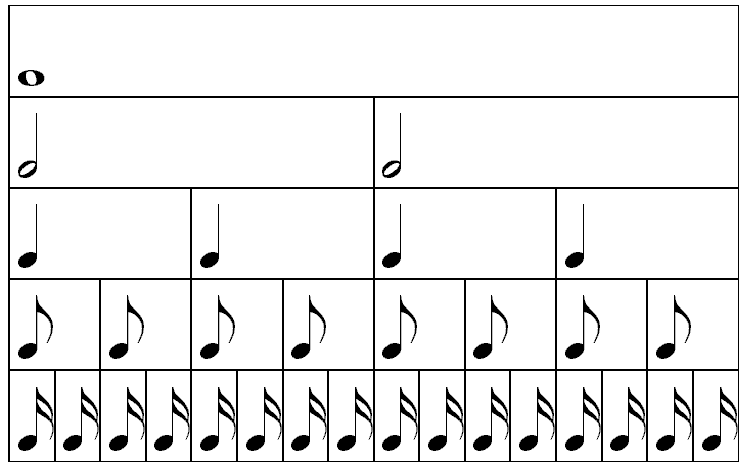Salsa is danced to a 4/4 count—but what the heck does that mean? Counting music is most easily achieved if you know how to read music (so you’re already ahead if those jazz band years in middle school still ring a bell). If not, don’t worry. Learning the value of each note is pretty easy. The graph below, a copyright-free image compliments of Wikimedia commons, shows you what each note requires to make a count of four:

The top value is one whole note, the second is two half notes, the third is four quarter notes, the fourth is eight eighth notes, and the last is 16 16th notes. You can get much more in-depth when it comes to reading music, including understanding time signatures that dictate beats per measure and the value of each beat, but that’s likely way more information than the average salsa dancer is seeking out.
Listen to Your Gut (and the Music)
Counting aloud is the best way to decipher beats and counts. You’ve heard salsa instructors start a dance with “one and two and three and four and …” or “one, two, three four,” to help everyone pinpoint the music’s beat. Really, they’re just sub-dividing quarter notes in a recognizable manner. Practicing at home yourself, listening to salsa music, is the best way to teach your ear to pick up 4/4 beats.
Wait a minute. What does 4/4 even mean?
It’s pretty simple. 4/4 means there are four beats per measure. Oftentimes in salsa, the beats are four quarter notes—but technically can be one whole note, two half notes, and so on (check out the illustration above for examples of the options!).
When counting aloud, you’ll most likely use numbers and the word “and.” The downbeat in each measure gets the number while the upbeats get the “and.” This is by far the most common, but it’s not a rule. You might meet some instructors who use vowels as well, count out “trip-a-let” or even make up triple-syllable words.
Reading sheet music comes in handy when you’re also teaching yourself how to count. For instance, if you have a 4/4 measure that includes one half note, one dotted quarter and an eighth note, you might say, “one, two, three-and four and.” If numbers and “and” don’t work for you, experiment. There are a slew of methods you can find and test out online. Unless your goal is to become an instructor, you’ll probably be the only person listening to your unique method anyway.
Tools of the Trade
It might seem like some people naturally pick up how to count music while others struggle longer. That’s okay. A metronome can be a great tool to help you keep time. It’s your steadfast tempo guide, and there’s a reason musicians use it. You can also use it when listening to music as it helps you identify beats and values.
Pay close attention to your instructors when they count aloud or, better yet, ask them to help you identify the 4/4 measure before or after class with popular songs they play. Something few instructors make transparent is that they’re not always right. There are certainly times when someone counts wrongly aloud, but unless it’s a glaringly obvious mistake (it won’t be, it will be subtle), nobody is the wiser. Kind of like with dance, sometimes sheer confidence can help you seem like you know what you’re doing!
What About BPM?
Beats per minute are an easy way to see if a song might be suitable for a certain dance. In salsa, the BPM ranges from 120-250ish, with most popular songs hitting around 165. It’s just what it sounds like: How many beats are there in each minute? You may have seen some salsa pros and instructors say offhandedly, “This is a 210 bpm song, so—” and be amazed that they could know that instinctively. They’re likely close, but might not be right on point. The song could easily be anywhere from 180-225 and they’re close enough that nobody will argue with them.
The only real way to know a song’s BPM is to listen to the song and its beat. Close your eyes and, if you’re having trouble, try to pick out the drums (if applicable). Watch the second hands on a clock or a stopwatch. Count for 15 seconds, multiply by four, and you have your BPM. DJs are especially good at ballparking it, since their job is to seamlessly segue from one song to another, and they need to do this with beats.
Of course, if you don’t know whether a song is salsa-approved or not and aren’t confident in counting music, the simplest way to find out is to dance to it! You’ll discover quickly if you’ve found a new gem with a great salsa beat, or if it’s better suited to another kind of dance. The odds are high that if a song is great for salsa dancing, another salsero has already made the discovery—so an online search can save you a big headache!

Leave A Reply